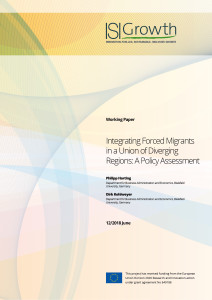This paper uses a two-country setup of the Eurace@Unibi model to study the economic impact of a sizable level of forced migration into two countries that form a political and currency union. We consider the case in which the origin of migration is outside the union and immigrants exhibit skill levels that are on average considerably lower compared to the skill levels of the domestic labor force in both member states of the union. We assume that these skill gaps constitute a significant hurdle for integrating migrant workers into the labor market. Moreover, we assume that the two countries differ regarding their institutional setting, in particular with respect to the labor market, and they differ regarding the production technology operated by firms in the countries resulting in different levels of productivity and economic activity. In simulation experiments, we examine the effect of different schemes of allocating migrants among the two countries, and analyze the effectiveness and implications of different policy measures aimed at fostering the integration of immigrants into the labor market.
Integrating Forced Migrants in a Union of Diverging Regions: A Policy Assessment
Philipp Harting
Department for Business Administration and Economics, Bielefeld University, Germany
Department for Business Administration and Economics, Bielefeld University, Germany

